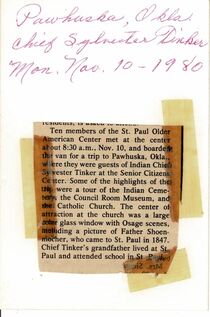 The photo above was taken in the Senior Citizens center in Pawhuska, Oklahoma, on Monday, November 19, 1980. A group of ten senior citizens, from St. Paul, was hosted by Osage Chief Sylvester Tinker during a tour of several area attractions. I recently found the photo in a package of St. Paul Information given to me by my cousin [1]. A taped newspaper clipping, on the back of the photo, appears to be from an area newspaper. The aged Scotch Tape partially obliterates the text, so I have tried to quote it below: "Ten members of the St. Paul Older American Center met a the center about 8:30 a.m., Nov. 10, and boarded the van for a trip to Pawhuska Okla., where they were guests of Indian Chief Sylvester Tinker at the Seniors Citizens Center. Some of the highlights of the trip were a tour of the Indian Cemetery, the Council Room Museum, and the Catholic Church. The center of attraction at the church was a large color glass window with Osage scenes including a picture of Father Schoenmaker, who came to St. Paul in 1847. Chief Tinker's grandfather lived at St. Paul (Osage Mission) and attended school in St Paul." When I first saw the photo, I couldn't identify many of the people. So, I posted it here and shared it to the St. Paul community page, Hometown St. Paul, Kansas, where I asked for help, and got some. Here are the names. From Left to Right:
Thanks to Cousin Karen Steinbacher for the package of interesting St. Paul information!
What Could Be Cooler Than a Sixty-Three-Year-Old Photo of Joe, on a Motorcycle, in Front of The Old Goodsel Service Station? That was a pretty cool motorcycle that Joe Dunavan was riding when he was a sophomore at St. Paul High School. But remembering the changes that have occurred on both sides of Highway 47 (then 57) is also pretty neat. I remember the location, because I lived in the house across the street when the picture was taken. That upstairs window was my bedroom (More on that later.) I am assuming Joe was in front of the old Vitt - Goodsel service station. The perspective looked about right when we stopped and took a photo a few days ago. Much has changed on both sides of the highway since 1960. 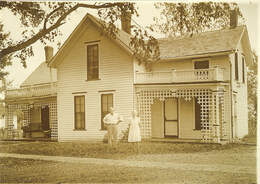 Charles and Hattie Cooney Charles and Hattie Cooney SOUTH OF THE HIGHWAY: The Cooney House. Starting with the top photo, at left is the 'Old Cooney House.' That home was built in the 1880's by my great grandparents Charles Cooney Sr. and Mary Lucretia Cooney. Later, my Grandparents Charles Jr. and Hattie Cooney lived in the house. After Hattie's death, in 1954, we moved back to St. Paul and lived in the house until after Charles's death in 1958. It was a charming, old two-story home with two porches on the front, and a third on the back — also two porch swings and a covered, stone well near the back door. Less charming was the fact that it was heated entirely with wood and coal. There was one gas line that fueled an old iron cook stove. My mom didn't have much patience with the situation, and we added more gas plumbing and installed a modern range and two downstairs gas heating stoves. Even with gas heat downstairs, the upstairs bedrooms got cold! Another problem was a very poor foundation that was collapsing into the cellar. 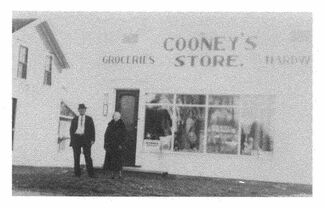 Charles and Hattie in Front of Cooney Store Charles and Hattie in Front of Cooney Store The Cooney "Little Store." To the right (west) of the Cooney House is the old Cooney Grocery Store. It was a small frame building with doors on the front and back. There were windows across the front. The interior was basically a 'general store' with floor to ceiling shelving on three walls and a counter with a glass display case. The shelving behind the counter had one of the old rolling library-type ladders. There were three or four shelving units in front of the counter and that was about it. After my grandparents retired, at least one other family, I believe the Bozone's, ran the store for a while. To the right of the Little Store (top photo) is another small building that served as an electrical and radio repair shop for the Bozone family. I believe Max DeVilbiss also ran a repair shop there before moving his electrical-TV repair work up to the main business district. The color photo, above, also shows the east end of a house. In 1960 that was the home of Mr. and Mrs. Arnold Smith. The Voorheis Family currently lives there. 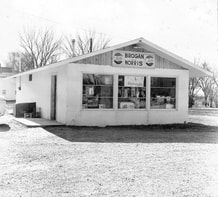 Brogan and Norris Grocery Brogan and Norris Grocery Brogan and Norris Grocery. The Cooney house photo shown above barely made it into the camera. A year or so after my grandfather's death, my parents and I moved a block northeast to Layfette Street. At about that time they, and Charles and Magdelene Norris, were selling our business in Erie and planning a new grocery business in St. Paul. This store was built on the site of the Cooney house, which was razed in 1961, and Brogan-Norris Grocery opened in 1962. We retained the "Little Store" for a few years, using it as a storeroom for the main building. It was eventually razed [2]. After my parents and the Norris' retired in 1974, the grocery store saw several owners, one of whom expanded the building toward the west. Then in about 2010 Michael Beachner bought the building and turned it into his business office. North of the Highway. In 1960 Ella Hentzen lived directly across the street north of my grandparents' home — on the far east end of the block. That home remains with new occupants. Everything else has changed since Joe had his picture taken. 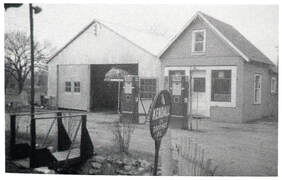 Vitt-Goodsel Service Station. Vitt-Goodsel Service Station. Vitt - Goodsel Service Station. In about 1948, Art and Nellie Goodsel purchased a Kendall Service Station from Fred Vitt. Over the next 10 - 15 years the Goodsel's made several more changes. From the perspective of the top photo, I am pretty sure Joe was in the driveway of the Goodsel station. If you look at the top photo, the second story window of the Cooney house was my bedroom. I recall several evenings of loud high-performance exhaust sounds with a lot of loud talking and laughter. I learned later that some of that revelry was probably related to bootlegging liquor into still-dry Oklahoma. 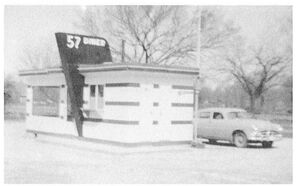 Goodsel's 57 Diner Goodsel's 57 Diner 57 Diner In 1954, Art and Nellie opened a ten-stool diner on the lot west of their filling station. The metal diner building, which sported a neon "57 DINER" sign, was manufactured by Arthur Valentine's, Valentine Diner Company, in Wichita. after it was ordered and site preparation was completed, one of Valentine's "canned businesses" was moved on site fairly quickly. This small diner, plus the filling station, was a preview of things to come on this block. The New Goodsel Filling Station, Grocery - Diner (1962). The January 26, 1961, issue of the St. Paul Journal reported "Last week a new filling station was started by Art Goodsel but the cold weather has halted the work for now." Other news stories of that week reported temperatures of -2°. In 1962, a local, upbeat publication about St. Paul's progress featured the new Goodsel Grocery, Filling Station and Diner on the front page. The large, 1/2 block long structure and parking area, included a filling station on the east end, and a much larger diner on the west end. In the area behind the diner was a small grocery store. The back of the building included a, high-bay garage and car wash. There were gas pumps in front of the building and gas/diesel pumps at the east end. As a sidenote, for a time, there were four grocery stores, three service stations and at least three restaurants in St. Paul! Same Building, 60 Years of Change. After Art and Nellie retired, their daughter Viola, and husband Howard, made a pretty significant change to the west end of the building. The grocery store was converted into a dining room, and the diner was renovated with more seating. For several years the Kennedy's, and later, Melinda and Perry O'Brien, operated the restaurant as the Tic-Toc and Boot's and Saddle Supper Clubs. In doing so, they served some of the best fried chicken in Southeast Kansas. Sorry Crawford County — That's a fact! The Lodge Steakhouse and Restaurant. Shortly after we returned to St. Paul in 2008, the old Goodsel building changed hands and received a major facelift. Externally, the front part of the building was covered with log siding. Both the front and original service bay got new, peaked roofs. Inside wall also got the log-look treatment. All-new kitchen equipment was installed and most of the front part of the building was renovated into dining room, and a nice bar was added to the southwest corner of the dining area. The restaurant offered good menu variety ranging from lunch specials to fine evening dining. Roy and Janis Carter managed the business for a few years, until it closed. Budd's St. Paul Lodge. In 2020 the building took on new life. Don Budd, a Kansas City real estate developer, with a deep passion for hunting and the outdoors, bought the building and did another impressive renovation. In addition to a retail area and very nice bar in the front, the back of the building has been converted to rental lodging quarters for visiting hunters. The business is seasonal and, with it being October, we are heading into the season. If you would like to look around the lodge, as it is now, here is a link to Budd's St. Paul Lodge website: Hunting Lodging | Budd's Saint Paul Lodge | United States (buddssaintpaullodge.com). Some Background Information:
1. Thanks to Art Goodsel for sending me the photo of Joe in front of this folk's service station. 2. I do not recall exactly when the old Cooney store was torn down, but likely in the early '70's. After we moved to Wichita, we came home for Christmas one year and stayed with my Parents. On Christmas morning dad got a call from a customer. "Bob, you might want to check the old store building. There is something running out from under the door!" Dad and I went over to check. It was very cold, and the space heater had gone out. About 15-20 cases of soft drinks had frozen, the cans were bursting, and the floor was flooded with an oozy, sticky, frosty mess. Merry Christmas! Today, May 11, 2023, marks the 139th anniversary of our "new" St. Francis Catholic Church. Seems like we should start planning for its 140th celebration! The majestic stone building has evolved constantly since its dedication on May 11, 1884. Its steeple has grown, and the entire building now sits four feet higher than it did when construction started in the 1870's. The stained-glass windows we take for granted were added about 16 years after our ancestors started using the Church. Another thing we have taken for granted is its nickname "Beacon on the Plains." We suspect the brightly lighted steeple, visible for miles around the region, has something to do with that. But the nickname is not quite right! The term Beacon on the Plains was coined by Sister Mary Paul Fitzgerald in her book Beacon on the Plains, when she wrote: “In the fifties, the mission was something of a beacon light to the few scouts, weary teamsters or perplexed travelers who stopped for rest, refreshment and supplies for which they customarily paid nothing. Not infrequently the missionaries rescued individuals lost on the plains …” She was speaking of the 1850's, and the original Osage Mission log church, and the mission that surrounded it. 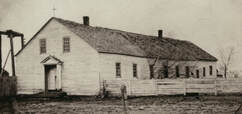 The Old Log Church sat about 200' west of the existing church. The Old Log Church sat about 200' west of the existing church. The old log church also carried another important designation that seems to be forgotten — The Cradle of Catholicism in Southeast Kansas. That designation refers to the wide-spread missionary work that extended well beyond southeast Kansas. Our Osage Mission Jesuit priests actually covered a five-state area including Kansas, southwest Missouri, Oklahoma, northwest Arkansas and at least one location in Colorado. This designation can probably be expanded to include a very large number of Catholic vocations that occurred here — but that's another story. Some related links from our website: The following article appeared in the October 30, 1911, issue of the Chanute Daily Tribune. The Passionists had shown interest in establishing a new, western location in St. Paul 18 years earlier. Less than a year later, in September of 1894, they formally took possession of the Jesuit property, including the original Jesuit Monastery. For several years the Passionists made significant improvements to St. Francis Catholic Church, including restabilizing it's foundation. However, this article announced a major commitment to erect a large and elaborate monastery and retreat house in our community. The new 3-story brick and stone building, with a full basement, would cost "something near $50,000." 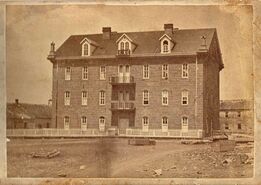 Jesuit Monastery Click to enlarge Jesuit Monastery Click to enlarge The Jesuit Monastery, completed in 1872, was razed to make room for the larger Passionist Monastery. That 3-1/2 story building sat about 60' west of the existing church and in about the same position as the existing St. Francis Rectory. Our Passionist era lasted more than 90 years. Those who remember the Passionist Monastery and Novitiate period remember many priests, students and brothers, and an all-male choir. On Church feast days we often had three Masses being said, at the same time, as older priests watched from the lower panels of the stained-glass windows on each side of the main altar. We had our own small slice of Rome right here at home. We Didn't Realize What We Had Until We Lost It! Some Reference Information:
For some more information about our Passionist era, follow these links to Our Story Chapters:
Here is another look at the Passionist Novitiate years through the eyes and website work of a former student — Steve George. Steve's YouTube Channel includes some of the Gregorian Chants we grew accustomed to hearing. Here is a later article, from the Chanute Weekly Tribune that discusses some of the building's details including a steam lighting system: As of April 28th, our Osage Mission - St. Paul story is 176 years old. However, simply being old doesn't necessarily make us "historic." The big flat stones that line Flatrock Creek are very old, but not historic. They are rocks. There are many definitions of "historic" but a simple one relates to "Significance" or having the potential to yield information important to our understanding of the past. In looking at a plot of land near the east edge of St. Paul, Kansas, the word significance takes on substantial meaning. Let's define that plot as the land that currently contains our schools, St. Francis Catholic Church, the Rectory, and the parish gardens. In other words, the area from highway K-47, north to Carroll Street; and from 1st street east to Udall Road. During the past 176 years that piece of real estate has seen four distinct configurations. Three of those configurations have Kansas state and national significance.[1] There is some overlap among these configurations, but each is unique. See the timeline at the bottom of this page. 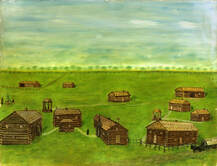 Click for More Information. Click for More Information. 1. The Catholic Osage Mission (1847 - 1870). The mission was managed by the Jesuits, with the Lorettos assistance, for the government. During its twenty-three years the Osages and missionaries experienced famine, epidemics and the Civil War. Yet, the mission was successful in educating young Osage children and converting adults who accepted conversion. Several of the Osage students, and their offspring, went on to become successful, even prominent, in life. In gratitude for the Jesuit's service, the Osages gifted land to Mission Director Father Schoenmakers. Part of that land is St. Paul, Kansas. Also, while running the Osage Schools, the Jesuits established more than 150 mission stations, across a five-state area. Many of these stations became churches or the seeds of new communities. This is one of the reasons the mission, and its old log church, earned the nickname "The Cradle of Catholicism in Kansas." The missionary influence extended well beyond the border of Kansas and into Missouri, Arkansas, Oklahoma and even Colorado. 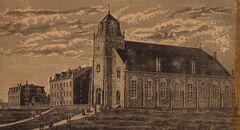 Click for More Information. Then follow the bottom link to "Regional Boarding Schools." Click for More Information. Then follow the bottom link to "Regional Boarding Schools." 2. Jesuit Monastery, Boarding School (1870 - 1892). As the Osages left Kansas, Father Schoenmakers formed a town company and started developing the very unique community of Osage Mission. He also set out to build several large stone buildings - a new church, a 3-1/2 story Jesuit monastery and a men's frontier boarding college, St. Francis Institute. Across the street, south, he and the Lorettos built St. Ann's Academy. St. Francis specialized in business education, St. Ann's in arts and music. These boarding schools attracted bright students from across the eastern states as well as local's and a few Osage students. Some of the boarding school students progressed to prestigious eastern colleges. 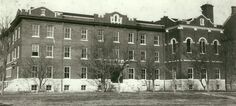 Click for More Information, then follow bottom link to "The Passionist Influence is Expanded." Click for More Information, then follow bottom link to "The Passionist Influence is Expanded." 3. The Passionist Influence (1893-1975). The early 1890's was a period of painful transition. In 1892 the Jesuits left Osage Mission and relocated to St. Mary's. In 1895 St. Ann's was destroyed by fire. Without resources to rebuild, the Lorettos left shortly after. Also, in 1895, the town of Osage Mission changed its name to St. Paul. Within a few short years we lost two educational institutions and the pioneering religious influences that founded our town and schools. We also lost part of our identity. But in the midst of that turbulent period there was a silver lining. In April of 1893 a Passionist priest from St. Louis traveled to St. Paul to give a retreat. At the time the Passionists were considering establishing a location farther west, and the priest, Rev. O'Keefe, was impressed with the location and the obvious devotion of the local congregation. In April of 1894, the Passionists took possession of the Jesuit property in Osage Mission, and began a long relationship that involved upgrades, repairs and the eventual construction of a new monastery and retreat house, and eventually a Passionist Novitiate. During its time, the Novitiate and retreat house hosted priests and novices from across the nation. Shortly after its construction, in 1914, the monastery sheltered fourteen Passionist exiles from Mexico. These men had driven from their monastery in Toluca, Mexico and arrived in St. Paul penniless and exhausted, but thankful for their lives. For years, we had our own slice of Rome, right here in St. Paul, and didn't realize what we had until the Passionists closed the monastery in 1983. 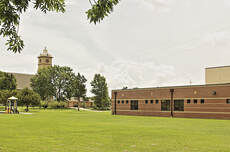 4. Present Church, Rectory and Schools (1923-Present). From a configuration standpoint, Phase IV solidified when the present St. Francis Rectory replaced the Passionist Monastery in about 1986. But in a practical sense, the Phase IV configuration occurred over the span of about eighty-six years. During this period: the “new” St. Francis school (current Middle School) was built in 1923; the existing grade school was completed in 1953; and our new high school was completed in 2009. Completion of the high school marked 162 years of schools structural evolution on that two-block piece of land - and we are still going. As of today, we are the longest, continuous operating, education tradition in the state of Kansas! We need to protect this legacy. Some Reference Information.
1. Significance and Relevance. Kansas State or national relevance means, in my opinion, that we are a lot more important than we think we are. During the past 26 years or so, our historical self-awareness has faded. There have been many books, thesis, journals and papers written about the Osage Catholic Mission, the town of Osage Mission and early St. Paul. There was also quite a bit of information published about the national Anti-Horse Thief Association which prospered while being managed locally. Twenty-six years ago, we had an active historical society, had just built a museum, published a 330-page hardback book about our history, had reprinted several other books about our local story, and we hosted a very successful Sesquicentennial Celebration [2]. Prior to that, historical awareness was just part of living in St. Paul. Also consider the Pruitt family's efforts to establish the Oak Grove Schoolhouse, south of St. Paul, on the National Register of Historical Places. Much of their justification for its historical relevance is based on its relationship with the Osage, the Osage Trail and with Osage Mission. Here is a link to the Historic Oak Grove Schoolhouse website: Historic Oak Grove Schoolhouse (1877) Why shouldn't St. Paul be a State or even National Historic site? It could have a pretty substantial effect on our local economy, churches, schools and lifestyles. 2. 1997 Sesquicentennial Celebration. Follow the link below for a YouTube video about the 1997 sesquicentennial celebration. Considering the people who were here, and the events, it was very successful! https://youtu.be/R8m0f-D32ts Illustrations:
The first post was a success story about the Greenbush, St. Aloysius Historical Society's work in beating their drum to keep their story, including Father Colleton's story, alive. However, Father Colleton's home base didn't do well. 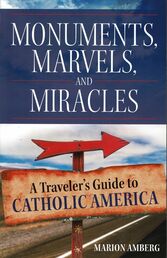 A couple of weeks ago we published an article about a chapter in Marion Amberg's book Monument's, Marvels and Miracles, A Traveler's Guide to Catholic America. That chapter, about Catholic Places in Kansas, listed eleven Catholic Churches or other sites that stand out because of their historical relevance or beauty. Each chapter in Marion's book also includes an article about a special place or story. These articles labeled "Finding Faith" are about sites with stories that are unique to their state. We were delighted to see that the Kansas Finding Faith spot was Greenbush! Her comments include the promise missionary Philip Colleton made when caught in a dangerous prairie thunderstorm in 1869; and the historical society's efforts to keep the promise. For the first article, including the authors comments about Greenbush and Fr. Colleton, follow THIS LINK. The Kansas Sites: The eleven Catholic-related sites in Marion's book are:
It was hard to believe that the Cradle of Catholicism in southern Kansas missed the author's eye. Especially since Father Philip Colleton's home base was here at Osage Mission. The missionary trip that Fr. Colleton was returning from was one of many he made to the churches and mission stations between Mt. Vernon, Missouri and Pueblo. But even in talking about Father Colleton's fateful trip, she didn't mention the mission. Oklahoma? Puzzled, I took a look at the Oklahoma chapter that begins on page 384. Sure enough, the first Oklahoma church is the Immaculate Conception Catholic Church in Pawhuska, also known as The Cathedral of the Osage. I was encouraged for a moment because the central subject of the Pawhuska story is the spectacular Schoenmakers window, depicting Father John Schoenmakers, bringing the Gospel to the Osage Nation.[1] BUT, no mention of the Osage Catholic Mission that Father Schoenmakers led for thirty-six years. Father Schoenmakers didn't take the Gospel to Oklahoma. He preached it to them right here in Southeast Kansas. In fact, our Jesuit missionaries weren't able to travel to Oklahoma very much after the Osages left Kansas in 1870. Contacted the Author. I sent Marion an email and was very polite. I told her we were pleased to see that Greenbush was the subject of her Finding Faith article for Kansas. I said that their local historical society was very active for a town of about 20, and they have a very effective communication network. But I also gave her a brief description of the Osage Mission and early St. Paul, and sent links to our acatholicmission.org website, as well as our St. Francis - St. Ambrose site. We were surprised we weren't included in her book. Marion responded in six days — pretty quick since she was in the process of moving from Santa Fe back to the Midwest. "Honestly, I don't know how I missed St. Paul/Osage Mission." She explained her 'multi-pronged' research process which included contacting dioceses, state historical societies and tourism bureaus among other sources. We just didn't show up. She has a couple of other book projects in process and believes we will be in one of them. Our Osage Mission, early St. Paul history has a lot of potential economic and community value if we develop it. Maybe we should see if we can borrow Greenbush's drum. Some Reference Information.
1. For a brief bio on Father John Schoenmakers, including a photo of the Immaculate Conception Catholic Church Schoenmakers window at Pawhuska, Click HERE. The tiny town of Greenbush, Kansas, has done a remarkable job of keeping their story alive. In doing so, they have kept a part of our Osage Mission story going. 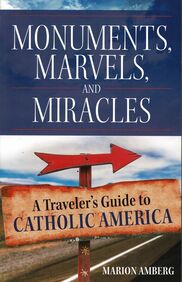 A few weeks ago our daughter gave Rosie a couple of books for her birthday. One of them was Marion Amberg's Monuments, Marvels, and Miracles; a Traveler's Guide to Catholic America. Stacy knew it would be used because we tend to gravitate toward old churches and missions in our travels. The Table of Contents of the 479 page book is arranged in seven main sections, each covering a geographical area: Northeast, Mid-Atlantic, Southeast, Midwest, Mountain West, Southwest and Pacific West. Each section includes a map of the geographical region, and individual maps of each of the states in that region. State maps have numbered travel symbols that correspond with articles about churches, missions or other Catholic locations in the state.  Finding Faith. In addition to the numbered symbols and articles, each state chapter also has an unnumbered sidebar article titled "Finding Faith." These are special sites with stories that are unique to their state. Each state has only one Finding Faith article (except New York and Texas). 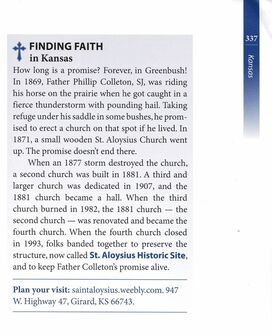 Click to enlarge Click to enlarge The Finding Faith article for Kansas is about — Greenbush! If the page shot at right doesn't enlarge well on a phone, it says: "FINDING FAITH In Kansas How long is a promise? Forever, in Greenbush! In 1869 Father Phillip Colleton, SJ, was riding his horse on the prairie when he got caught in a fierce thunderstorm with pounding hail. Taking refuge under his saddle in some bushes, he promised to erect a church on that spot if he lived. In 1871, a small wooden St. Aloysius Church went up. The promise doesn't end there. When an 1877 storm destroyed the church, a second church was built in 1881. A third and larger church was dedicated in 1907, and the 1881 church became a hall. When the third church burned in 1982, the 1881 church — the second church — was renovated and became the fourth church. When the fourth church closed in 1993, folks banded together to preserve the structure, now called St. Aloysius Historic Site, and to keep Father Colleton's promise alive." _________________________________________________ Plan your visit: saintaloysius.weebly.com. 947 W. Highway 47, Girard, KS 66743" Other Finding Faith Examples: Were we surprised that Greenbush was selected for a special article? Yes - but no one had to pick us up off of the floor. They have always done a good job of beating their drum, so to speak. They have an active, incorporated historical society with a large number of members. They also have an attractive, well laid out website. But more than that, they have a strong community following; and their "community" seems to stretch across the country. The St. Aloysius Historical Society keeps Father Colleton's story alive, and also maintains their historic cemetery and church ruins. They, and the Southeast Kansas Education Support Center, complement one another well, and their annual celebrations attract hundreds of people! It is no wonder they were featured in the recent regional Kansas Samplers Foundation Big Kansas Road Trip. But! When we looked through the book for Finding Faith comparisons in other states, we were very impressed. Greenbush is in very good company:
Some Reference Information:
1. Monuments, Marvels and Miracles, A Travelers Guide to CATHOLIC AMERICA, by Marion Amberg, copyright 2021, Our Sunday Visitor Publishing Company, Huntington, Indiana. The book is available through Amazon, Barnes and Noble and several catholic book outlets. As we begin our Memorial Day weekend, and attention is focused on the graves of our family members, we should look around. We have been blessed with two beautiful and remarkably historic Cemeteries. St. Francis Catholic Cemetery. Located about 3/8 of a mile east of St. Paul, the cemetery was started by Father John Schoenmakers in about 1868. But the cemetery includes graves that were relocated from the original old mission cemetery that date back to 1852. In 1871, as the town of Osage Mission was growing rapidly, Father Schoenmakers urged settlers to move their family graves from the older graveyard to St. Francis. The original mission cemetery was located in the east part of the existing Miles Field football field, and the residential neighborhood just east of there. [1] Hope Cemetery. As harsh as it sounds today, Protestant settlers were not allowed to be buried in St. Francis Cemetery. For a few years, non-Catholic settlers were buried in small cemeteries scattered around the area or at family homes. In 1874, Hope Cemetery was established one mile north of St. Francis Catholic Church. Over time, many graves were relocated from smaller graveyards or home plots. Like St. Francis, Hope tombstones represent many stories from the early Kansas frontier and the Civil War period. [2] Click for links to cemetery information: 1. St. Francis Parish Cemetery, St. Paul, Neosho County Kansas, 1852~2008, Viola Anne Gouvion. This 670+ page book is a local treasure for historians, geologists or general family information. In addition to cemetery records, the book contains some history of the original mission cemetery; the transition to St. Francis Catholic Cemetery; and some general information about our church and parish. It it available from the Osage Mission - Neosho County Museum in St. Paul.
2. Hope Cemetery Records, August 1869 — August 2000, Osage Mission, now St. Paul, Neosho County, Kansas, Compiled by George M. Paine. The Hope records are now a multi-volume set that covers some history beyond 2000. There is also an addendum that includes cemetery maps. The Hope Cemetery books should be available from the Osage Mission - Neosho County Museum in St. Paul. 3. There is an interesting connection to President Lincoln in each of these cemeteries. .... our Osage Mission Ancestors Did Not Allow the Symbolic "Cradle of Catholicism" to Decay in a Remote Pasture! Funny thing about mistakes. They can be recognized and corrected quickly. But sometimes they seem to have an afterlife and just keep showing up. In the case of a certain photograph, and caption, it has haunted us for more than fifty years. 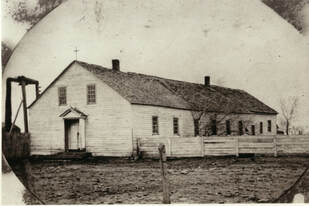 Our Original Log Church (Click to enlarge.) Our Original Log Church (Click to enlarge.) The photo is of a decaying shed in a pasture. It appears to have been of log construction with board siding. But how the conclusion reflected in the caption was reached is beyond me; and I would think, anyone who spent even a moment studying the mission. In its final configuration, the Osage Mission log church was covered with clapboard. That is where any resemblance with the photo ends. Our original St. Francis de Hieronymo Catholic Church, after its second expansion, was 35 feet wide + 90 feet long, with a roofline of about 16 feet. [1] The structure had nine side-windows, two chimneys. and two windows above the front door. Another glaring discrepancy is the depiction of it sitting in an open field with a fence behind it. During its final days, the church was part of the St. Francis Campus, which was made up of: Our "new," stone St. Francis Catholic Church, the 3-1/2 story Jesuit Monastery, and the St. Francis Institute men's boarding college. There is no lack of proof that the church was surrounded by other structures until it's final days. [2] The Very Thought! Mistakes are made, but this error keeps popping back up! [3] But the very thought that our Osage Mission ancestors would let their original church simply decay away is rather offensive. After all, that building is symbolic of the "Cradle of Catholicism in southern Kansas." It is also the visual focus of the "Beacon on the Plains" In Sister Mary Paul Fitzgerald's book of the same title. [4] I am fairly certain that my great grandparents, Charles and Mary Lucretia Cooney, wouldn't be happy with that caption! They were married in that church, by Father Paul Ponziglione, on April 27, 1874. Father Paul would probably be a little ticked too! Some Reference Information:
1. Descriptions of the log church vary a little. The width appears in some documents as 30 feet. But many descriptions say it was 35 feet wide. The 90-foot length is pretty constant. The original building was fairly large. All of the photos I have seen are of the side shown above. I don't know if the west side also had nine windows . 2. Our present "new" stone church was built between 1972 and 1884. It was dedicated on May 11 of 1884. During the next four years the original log building was used as a washhouse and playroom for the schools and monastery. The log church was finally torn down in July of 1888 allowing for construction of other buildings on the St. Francis campus. It was the last of the original Catholic Osage Mission buildings to be razed. It is noted that the Jesuit monastery, shown in photos above, is the first monastery on St. Francis grounds. The Jesuit structure was razed in about 1911 allowing construction of the Passionist Monastery that many of us remember today. 3. To the best of my knowledge the original photo, and caption, showed up in an otherwise very nice article in the Catholic Advance newspaper. That article, in the October 16, 1969, issue of the Advance, commemorated the 100th anniversary of the first Catholic Mass in Wichita. That mass was celebrated by Osage Mission Jesuit missionary, Father Paul Ponziglione. The article "Catholicism Begins in Kansas" actually goes back to Coronado's arrival in Kansas in 1541 and Franciscan missionary Juan De Padilla's martyrdom. But much of the article is focused on Osage Mission, Fathers Schoenmakers and Ponziglione, and mention of Sister Bridget Hayden. As noted, it is a nice article except for the photo, and especially the caption (and an incorrect build date of our current church). We have no idea of where the photo came from. But we certainly hope it didn't come from here! However, in recent years the photo, with caption, has shown up in the history page of a couple of Southeast Kansas church websites. In both cases, we notified the webmasters and provided a picture of the actual log church; and in both cases the photo was removed. Now it has shown up in a museum display. Oh Well. If you would like to look at the original article, the two-page spread is provided HERE and HERE. Just ignore the photo in the center of the second page. 4. Over the years the tall, lighted, bell tower on our "new" stone church has assumed the title of "Beacon on the Plains." That's OK, but the original mission church was the center of the mission addressed in Sister Fitzgerald's book, when she wrote: "In the fifties, the mission was something of a beacon light to the few scouts, weary teamsters or perplexed travelers who stopped for rest, refreshment and supplies for which they customarily paid nothing. Not infrequently the missionaries rescued individuals lost on the plains." I believe Sister Fitzgerald's Book, "Beacon on the Plains" is the best beginner's 'Osage Mission 101' available. "But being old or even first does not, in itself, make a place "historic." It is what was done during its time, that can make the place historical. With that in mind, the Osage Catholic Mission was a very historic and important place." We have been to the Cathedral of the Immaculate Conception, in Wichita, twice lately. When there, I tend to gravitate toward the Cathedral Commons area that connects the main Church with the auditorium, offices and other facilities. I know what is there. As you walk down a sloped entry into the commons there are two nicely done displays on the history of the Wichita Diocese. When you consider that reading material, or historical displays, are usually read from top-left to right; we here in St. Paul, Kansas are well represented at top-left. At the upper-left corner of the first display are two panels that discuss the first Catholic Parish in the Diocese of Wichita — Saint Francis de Hieronymo at St. Paul. That first panel shows a photograph of our current church and explains that the original mission was established by the Jesuits and Sisters of Loretto in 1847. It also explains that our current "new" church was built during the period of 1872 to 1884. But being old or even first does not, in itself, make a place "historic." It is what was done during its time, that can make the place historic. With that in mind, the Osage Catholic Mission was a very historical and important place. That is where the second panel comes into play. The second panel shows a picture of Father Paul Mary Ponziglione. Father Paul, an Italian Nobleman by birth, was one of Osage Mission's most recognizable trail-riding missionaries. The panel describes his far-reaching missionary work; and the work he did to bring the first Catholic Church into Wichita. But this is just a hint as to the role of the Osage Catholic Mission.
When the mission was established in 1847, the Jesuits had two important roles:
Priests like Father Ponziglione and Colleton started, and even built, several small churches in the region. In some cases, they even helped start Catholic schools. Father Colleton, in particular, provided literature and books needed to educate young Catholics and adults in the southeast corner of Kansas. If you would like to understand more about the wide-reaching missionary work of the Osage Mission Jesuits, follow these two links: Both of these links will open in a separate page or window. Gerald Butler, of Girard, provided this photo of the 1966 Kansas State Record Flathead Catfish and the men who caught it. The men are Gerald's Father Joe Butler and his friend, Raymond Wiechert of Brazilton. The fish was a lunker! It's weight, which was certified by Kansas Fish & Game, was 86.6 Lbs., 6 oz. It was 55-1/2 inches long, and it also measured 17 inches between the eyes. The fish was caught on a limb-line, in the Neosho River, about 2 or 3 miles south of St. Paul. It was so large they couldn't get it into their boat, so they towed it behind the boat until they could get it to the shore. They caught the fish on August 24, 1966, and it held the state record until the 1990's. 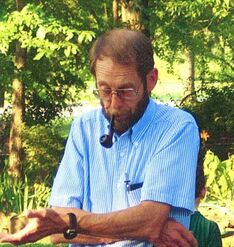 Jay Wiechert (Click to enlarge) Jay Wiechert (Click to enlarge) But There is More. Tim Harmon, of St. Paul, passed the photo and story on to us from Gerald and neither of them were certain of the spelling of Raymond's last name (Wichet?). They did know he ran a blacksmith shop in Brazilton. After a little research I confirmed Raymond's last name as "Wiechert." But Raymond and Edna Weichert's son, Jay Weichert, popped up in several Google searches keyed to: the family name, "Brazilton, Kansas" and "blacksmith." He is fairly famous in a rather macabre way. Between 1976, and his death on September 21 of 2016, Jay Wiechert manufactured every electric chair made in the United States, and quite likely, in the world. If you want to read more about Jay Weichert, you can follow THIS LINK: 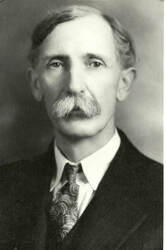 William Whites Graves William Whites Graves If W. W. Graves had chosen to be a journalist, a historian, a writer, a printer and publisher, a national law enforcement official, or a businessman he would have probably done well with any of these careers. But he chose to do it all and wrapped it up with the skills of an accomplished entrepreneur and businessman. William Whites Graves was, in fact, a model of the early post-frontier entrepreneur. He was smart and ambitious. He received a business education at the St. Francis Institution here in Osage Mission. Perhaps, more than anything he had learned to recognize, and sort out opportunities and grab those that would benefit him or even others. One of his early opportunities occurred in 1895, when B.B Fitzsimmons and his father, staked him in acquiring the Neosho County Journal (Later, the St. Paul Journal). In 1902, Fitzsimmons and some other Neosho County men sponsored Graves in a competition to publish the Anti Horse-Thief Association Weekly, which was a national newspaper. He submitted a successful bid, and the resulting contract provided the capital Graves needed to build a dynamic, fast-growing publishing business. In just a few years he moved into a larger building, acquired one of the first Linotype type-setting machines in the region, installed his own gasoline-powered electrical generation plant, and hired and trained people to run this printing business while he pursued other opportunities. Not only did Graves publish the A.H.T.A. Weekly newspaper, but he also took an active role in the organization’s reformation and growth. During the 1920’s he served as the organization’s national vice president and president. [1] Graves’ experience with the Fitzsimmons' and other supporters might have ingrained a sense of gratitude that he passed on. When German-born harness maker, Jo Sork, arrived at St. Paul in 1908, Graves invested in Sork’s acquisition of the Null harness shop, even though Graves had no background in harness making. Nevertheless, the Sork-Graves partnership in the Sork Harness Shop prospered until Sork’s retirement in 1935. 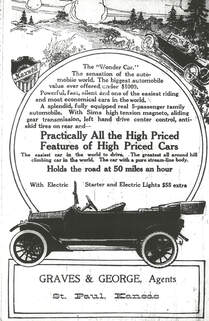 A Graves - George Maxwell "Wonder Car" Advertisement. A Graves - George Maxwell "Wonder Car" Advertisement. In 1915 W.W. Graves teamed with Ed George in selling the Maxwell Touring Car, also touted as “The Wonder Car!” At the time, the Maxwell was known for having innovative suspension and drive-train features that enabled it to hold the road better than any competitor; and given the condition of roads in those days that was a pretty big deal. Graves was no stranger to innovation. His previously-mentioned gasoline electrical generator was later replaced with a safer steam generation system. Private electrical generating systems allowed him, and his brother-in-law A.J. Hopkins, to open and operate three movie theaters — one outdoor and two indoor — several years before the electrical power grid arrived in St. Paul. While W.W. kept several business interests going, his mainstay was insurance. As early as 1900, he purchased the local insurance company of J.J. Thompson, representing the American Central, Hanover, Phoenix, and Springfield Insurance Company. In 1932 he partnered with Frank A. Munding in purchasing the insurance business of M.J. Kelley. In this business, they represented sixteen of the largest insurance companies in America. In 1946, he teamed with nephew Fielding S. “Hoppy” Hopkins in the Graves-Hopkins Insurance Agency with continued past Graves’ death and until Hoppy’s death in 1969. Graves and his wife Emma were devoted Catholics who supported their church. In 1932 they donated an entire public address system to St. Francis Catholic Church. Many of the church pamphlets, recitation books, and other materials were printed and donated. Graves was a charter member of Knights of Columbus Council 760 and was undoubtedly instrumental in their role of having Father Paul Mary Ponziglione's portrait painted and donated to the Kansas State Historical Society in 1906. [2] But one force drove Graves harder than his varied business interests. He was a passionate historian who loved to write. He also understood the role the Osages, the French fur traders, and the Catholic Church played in the settlement of Kansas. Moreover, the writer and historian owned his own publishing company. During the period of about 1916 and 1951, he published more than 15 books and publications, most of them dealing with the early history of southern Kansas. In his later days, Graves made building a public library in St. Paul one of his last priorities. Knowing his days were numbered, he turned his personal collection of books over to the local Women’s Home Demonstration Units and challenged them to make it happen. He knew he had chosen a formidable project management team and they did not fail. 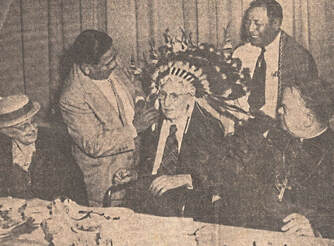 Parson Sun Photo of June 2, 1952, Showing the Presentation of an Honorary Osage Tribe Membership to Mr. Graves at his recognition banquet on May 31, 1952. Suzie Graves is at far left. Bishop Mark K. Carroll at far right. Parson Sun Photo of June 2, 1952, Showing the Presentation of an Honorary Osage Tribe Membership to Mr. Graves at his recognition banquet on May 31, 1952. Suzie Graves is at far left. Bishop Mark K. Carroll at far right. On the evening of May 31, 1952, a group of distinguished guests gathered in the gymnasium of St. Francis School. The banquet was sponsored by the 3rd District Kansas Press Association. About 240 people attended. It is hard to imagine that a banquet, in St. Paul Kansas, could be attended by the diversity of interest groups that were there. The group included a bishop, an Indian chief, farmers, businessmen, state officials, college presidents, Press Association executives, the president of the Kansas State Historical Society, pressmen from across southeast Kansas, and Graves’ friends from St. Paul. W. W.’s wife, Susie Gibbons Graves sat at his right side and was beaming with pride in most of the press photos that were taken that evening. Among the accolades bestowed on William Whites Graves that evening, two stood out. Bishop Mark Carroll, of the Diocese of Wichita, presented a Vatican Knighthood of St. Gregory on behalf of Pope Pius XII. He was also made an honorary member of the Osage Tribe, which made it possible for the Osages to declare him an honorary chief of their tribe — a very rare honor. Weeks later, on July 22, 1952, W.W. Graves collapsed and died of a heart attack in his home at St. Paul. It was less than two months since the banquet. It was then that the Eastern Kansas community realized they had almost missed a chance to recognize a life lived well. Some Reference Information:
1. For more information about W.W. Graves, and the Southeast Kansas, Neosho County, community involvement in the A.H.T.A., follow THIS link. The link should open in a separate window or tab. 2. For more information about Father Paul Ponziglione and the KofC portrait, follow THIS link. In the early spring of 2013 the Board of Directors of the Graves Memorial Public Library, in St. Paul, took on an interesting project. Board president, Lon Smith knew that the memory of library founder, William Whites Graves had faded. He also knew that Graves was a pretty remarkable guy. Lon came up with the idea of celebrating Graves’ 142nd Birthday on October 26th of that year. But beyond ice cream and cake, Lon wanted to leave something more permanent in the library. After a little brainstorming, we came up with the idea of an interpretive display about the life and times of W.W. Graves. There was a good-sized section of wall, in the front part of the building that would work. I agreed to take on the research and display panel work. Lon and board member Jane Ann Beachner would provide checking, proofreading, and financial backing. This is a good time to mention that this was my first shot at creating a full-up interpretive display. In my previous life, I had done a lot of maintenance and litigation research. I also supervised a group of artists and publishing specialists who were a lot smarter than I was. Some of their expertise had rubbed off, but it turned into a bit of a challenge. Over the next few months, I dug through nearly 300 articles, photos, letters, and other items that described Graves’ life from childhood through his death in 1952. The more I dug, the more fascinating this man’s life became. My early impression of W. W. Graves was that of a very intelligent, competitive, and religious young man with a solid work ethic. He had a strong and defining sense of morality, justice, ethics, and politics, both personal and public. He connected himself with the right people early on, and then let his personal attributes carry him through an exceptional life. One thing was very clear. His early exposure to the Jesuit missionaries who founded the Catholic Mission, and the town of Osage Mission was a driving force during his adulthood. As I pulled information together, I decided that individual display panels would cover five aspects of Mr. Graves’ life:
Then I turned to the task of laying out the display panels, which turned out to be fairly easy. By the time I collected the research material, I also had uncovered many, many photos, maps, illustrations, and other material that just had to be assembled into graphical format. I might add that a very large part of Graves's information came from a cousin who had donated two boxes of material to the local museum about a year before I started the project [1]. Also, with Graves having been the editor of several newspapers and a magazine, I decided to use the front pages of those papers as backgrounds for four of the panels. [2] 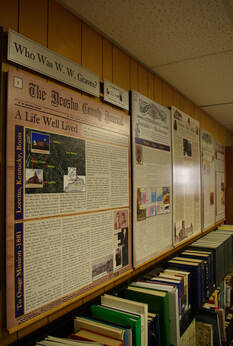 Finished display panels in Graves Memorial Public Library, St. Paul. Finished display panels in Graves Memorial Public Library, St. Paul. As I laid out panels, my wife, Rosie worked with me and offered suggestions and corrections. Then, library board member, Jane Ann Beachner, received semi-finished panel artwork and was my final editor. These two ladies caught a lot of my errors and made the display product much better. In the end, I learned (re-learned) a lot of proper punctuation from Jane Ann. In Mid-August I turned the panel art over to the Pitt State Graphics Department and our friend Larry Jump converted computer files into a set of five panels and some metallic introduction plates. Rosie and I built a set of simple mounting frames and in a matter of a few hours, one early September afternoon, the display became reality. With the project finished, we only had one more thing to do before the October birthday party. Rosie and I loaded our camper and made a 600-mile trip east. After spending six months getting very acquainted with St. Paul’s ‘Most Esteemed and Honored Citizen,’ [3] we wanted to visit the Holy Land of west-central Kentucky where his life began. We met Leo and Marie Schettler at a campground near Bardstown and spent several days roaming the area around Manton, Bardstown, Loretto, and Nerinx. We strongly recommend that trip for anyone whose family originated here in Osage Mission – St. Paul in the late 19th century. Those old central Kentucky Catholic church cemeteries contain a lot of very familiar names. Even if your family doesn't have Kentucky roots, you will likely find it interesting. Oh — by the way! You also will be in the heart of Kentucky Bourbon Country. The Maker's Mark Distillery is at Loretto, Kentucky. 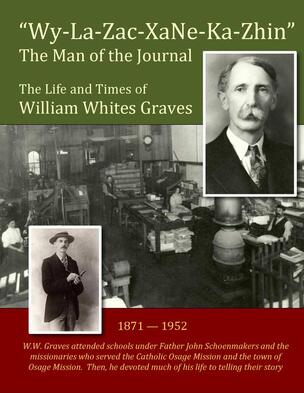 Click above to download a copy of the research document described above. Click above to download a copy of the research document described above. If you would like to get more familiar with W.W. Graves, and his eastern Kentucky roots, click on the cover page illustration here to open a copy of our research document. It is a 6MB PDF file and might take a moment to download. As noted above, the document was laid out to develop the storylines for the five display panels. Chapter 1 is an overview of Mr. Graves' life. The four remaining chapters expand on the important aspects of his life. You should expect some repetition among chapters. Some Reference and Background Information:
1. In 2012 St. Paul native Karen Hopkins Steinbacher donated two boxes of Graves-Hopkins material to the local museum. The boxes proved to be a treasure chest of family and local information. W.W. Graves was Karen’s uncle. In early 2014 I sorted through the boxes and cataloged the contents into the Graves-Hopkins Collection that is in the museum research room. 2. Graves was the publisher of the Neosho County Journal and St. Paul Journal (same newspaper, different names). He also published the Anti-Horse Thief Association weekly and the Kansas Knights of Columbus Magazine (Kansas Knight). 3. The phrase “Most Esteemed and Honored Citizen” was the headline of the July 24, 1952, issue of the St. Paul Journal that contained Mr. Graves’ front-page obituary. Click the upper page, below to open the entire page in a separate window or tab. As the Osages left Kansas for their Oklahoma reserve, the Jesuits and Sisters of Loretto had to shift gears rapidly. The Osage lands were opening for settlement; and the new town of Osage Mission was very attractive. It already had schools and trained educators. There was a Catholic Church, and a Methodist church on the way. But adequate school facilities were lacking. Some of the first white students, like Charlie Beechwood and Anna Duling, [1] were able to attend school in the original mission buildings, but new schools were needed. 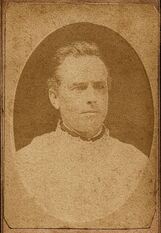 Father Colleton [2] Father Colleton [2] A school building-boom started in 1869 that resulted in construction of a several buildings including public schools and two regional boarding colleges. During this time, Father Philip Colleton, one of the most well-known missionary trail riders, traded his saddle for pen, paper and his ingenuity. He assisted with design and construction of some of the new schools. But he clearly had more in mind than just new buildings. According to W.W. Graves [3] one of the new and important, buildings was the St. Francis Hall: "The first building of any importance, of frame construction, was erected in 1869. It was known for many years as St. Francis Hall. At first the lower story was used as a library and reading room for the public. The ladies of the parish, in 1869, organized a library society, and held a social in the Mission orchard to obtain funds. There were a number of Osages still living in the locality, and they attended this social along with the whites. The ladies raised $500 in one day with which to purchase books. With these books, they started, during the fall of 1869 what was probably the first free public library in the state of Kansas. Socials were held annually afterwards to increase the number of books. For fifty years this library continued to be used by the public. At present part of the books are still in use in the St. Francis school library near St. Paul. The building is now part of the Monastery barn." [4] St. Francis Hall was a multi-purpose building. In addition to the first-floor library, the second floor was a public assembly room and was also used, by the Sisters of Loretto as a school for the younger girls of the community. But the library fit well into Fr. Colleton's plans for his regional missionary work. In addition to stocking the Osage Mission library, he was able to raise money to purchase religious books and pamphlets that he distributed to Catholic families in southeast Kansas and southwest Missouri. Over time he was able to build several small churches, some of which were surrounded by new communities. This is how parishes in towns like Baxter Springs, Columbus, Scammon and Galena were formed. Using present landmarks, St. Francis Hall was built near the present St. Francis Catholic Church parking lot driveway (There was not a parking lot at the time.). As noted above, the building was later moved to the general area of Prairie Mission Retirement Village where it was used as a Passionist monastery barn. Some Reference Information.
1. For more information about Charlie Beechwood follow THIS LINK. This link also includes information about Anna Duling, and the iconic painting of the Osage Catholic Mission that is attributed to Beechwood's memory of the mission buildings. 2. For more information about Father Philip Colleton, follow THIS LINK. 3. W.W. Graves talks about Father Colleton's role in building St. Francis Hall, and the reference library in several of his books. Among these are:
4. In addition to the above, Sister Mary Paul Fitzgerald has a full chapter about Father Philip Colleton, including his work on St. Francis Hall, his library and missionary efforts in the four-state area in her book Beacon on the Plains, St. Mary College, 1939. Beacon on the Plains was her doctoral thesis. On page 160 of her book (footnote 26), she notes there was a previous library formed in Lawrence Kansas in the summer of 1859. It was started by seventeen-year-old Anna J. Prentiss. 5. Photos. The photo of St. Francis Hall and the 1885 Sanborn map were obtained from the Kansas State Historical Society. The photo of Fr. Philip Colleton was repaired from a newspaper photo that appeared in the Neosho County Journal (later the St. Paul Journal). This February 15, 1900, newspaper article, about a catastrophic St. Paul Fire, makes us appreciate our present-day firefighting capability. The February 15, 1900, issue of the St. Paul Journal described a disastrous late-night fire that destroyed eight downtown business and nearly killed one of our citizens. Early attempts by volunteer firefighters, to fight the fire via a bucket brigade, were proving to be futile. That is when a trained fire company from Parsons was called in to support the locals. The fire company arrived on a special train and was able to contain the fire before it spread across an alley and to other businesses. The article mentions, in passing, that much of the damage might have been prevented if St. Paul had a fire company of its own. The $40,000 loss, adjusted for time, would have equaled more than $1.3 million today. We have come a long way since 1900 — especially during the past few years. We have a very well-equipped volunteer fire department with headquarters at the corner of Central and Main. The facility is central to Mission Township and occasionally travels outside of the township limits to assist other departments. Recent efforts, including grant activity, have added technology such as updated communications, a larger radio tower, thermal imaging cameras and training that the 1900 Parsons brigade could never imagine. Thanks to the thermal imaging technology, a recent residential structure fire was stopped in its tracks before it could destroy the home. Read the Article: The Journal article was on two pages. "Click to enlarge" does not work well with these old microfilm images. But you can click below to download and view each image in a new window. It should work well on a phone or tablet. Where Was the Fire? It took a while to figure out where the fire was. But clues from the Journal article and an 1899 Sanborne fire insurance map, helped me figure it out.
Some Reference Information: 1. Top Photo. The banner illustration at the top of the page is from two photos. The background is a photo of our existing Mission Township Fire Department building taken by local photographer Kent Davis — KD Shots. The inset is from the Cumberland Valley site discussed in "2" below. 2. An Early Volunteer Fire Department. The arrival of the Parsons Fire Department, by train, seemed strange to me. After doing some research, it appears it was not common but did occur. Today, rail-based firefighting is fairly common for large wildfires and some forest fire fighting. Here are a couple of links about modern rail firefighting. Both will open in a new window. 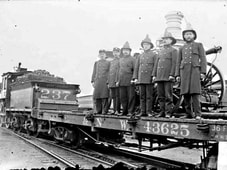 During my digging, I came across the Cumberland Valley Volunteer Fireman's Association website. The association was formed in 1901 for the purpose of adopting a uniform hose coupling and to develop a mutual aid system, among volunteer departments, along the Cumberland Valley Railroad. It is a neat story, and the site provided the inset photo for the banner picture at the top of the page. The link below takes you to their About Us page and you can look around the site from there, if you like. https://cvvfa.org/about-us/ |
Thoughts 'n ThingsSome 'Thoughts' and short articles about past and present-day St. Paul and the Southern Kansas - 4 State Region. Archives
December 2023
Categories
All
|
- Home
-
Our Story
- 1. The Stage is Set
- 2. The Osages Enter Kansas.
- 3. Earliest Commerce
- 4. Earliest Protestant Missions
- 5. The Catholic Osage Mission >
- 6. Progress and Tragedy
- 7. The Missionary Trails >
- 8. A Dangerous Balance - The Civil War >
- 9. The Osage Leave Kansas >
- 10. A Very Unique Community is Born >
- 11. Regional Boarding Schools >
- 12. Transitions
- 13. The Passionists Era Begins
- 14. Citizen Lawmen - The A.H.T.A. >
- 15. The Passionist Influence is Expanded
- 16. The Schools Today >
-
Characters
- The Osages
-
The Missionaries
>
- Father John Schoenmakers >
- Fr. John Bax >
- Mother Bridget Hayden
-
Fr. Paul Ponziglione
>
-
Father Paul's Memoir
>
-
Index - Father Paul's Memoir
>
- Dedication & Introduction
- IX. Construction & Acceptance of Mission Buildings.
- X. Fr. Schoenmakers Arrives at Osage Mission
- XI. Miss Lucille St. Pierre Came to the Neosho
- XII. Progress of the Schools
- XIII. Origin and Development of the Roman Catholic Church in Kansas
- XXVII - Winds of War
- XXVIII — Fr. Schoenmakers Return
- Chapter XLII - Farming Issues, Death Of Father Colleton
- Chapter XLIX - Includes The Death of Fr. Schoenmakers
- Chapter L — Dedication of the New Church
- Conclusion
- Appendix I — Copy of a letter to Sister M. Coaina Mongrain about the coming of the Sisters of Loretto at Osage Mission
- Appendix 6 — A Sketch of my Biography
- Appendix 7 - Letter to W. W. Graves
-
Index - Father Paul's Memoir
>
-
Father Paul's Memoir
>
- Father Philip Colleton
- Brother John Sheehan
- W. W. Graves
- 17 Sisters
- 17 Sisters II - Fr. Fox's Sermon
-
Who's Behind the Window
>
- Who We Were 120 Years Ago
- 1. The Thomas Carroll Window
- 2. The W.W. O'Bryan Window
- 3. The Jas. Owens & Family Window
- 4. The C.P & C.J. Hentzen Windows
- 5. The Dr. McNamara & Family Window
- 6. The Fitzsimmons & Family Window
- 7. The Parents of T.K. Joyce Window
- 8. J.E. Sevart & Family Window
- 9. The Rev. John Schoenmakers S.J. Window
- 10. The Patrick Diskin and L&M George Window
- 11. The J.A. Johnston & Family Window
- 12. The Peter & Jacob Bonifas Windows
- 13. The Mr & Mrs. Patrick Keeting Window
- 14. The John Butler Window
- 15. The Mr. & Mrs. Gutting Window
- 16. Rosette Window Above Doors
- 17. The Michael A. Barnes Window
- 18. The Henry M. O'Bryan Window
- 19. The John and Bridget McCarthy Window
- The Sodality Windows
- The Church Women's Bonfire (Graves)
- Beechwood
- John and Margaret Naudier
- Fr. Tom McKernan - The Poet Priest of Kansas
- The Dimond Family and Estate Sale
- Dear Sister >
- A Year and a Day — Passionist Memories.
- Mary Elizabeth Lease
- K of C Council 760 - The Early Days
- Our Hometown Boys
- SPHS Class of 1956
-
Places
- The Great American Desert
- St. Francis Catholic Church
- St. Francis de Heironymo Catholic Church Grounds
- St. Paul - 135 Years Ago
- St. Paul - 1890's as a Scale Model.
- St. Paul - The Booming 60's
- Osage Mission as a Statewide History Finalist
- St. Francis Cemetery
- Hope Cemetery
- The Basement Chapel
- World War I Museum Display
- St. Paul Middle School >
- Ladore
- St. Boniface, Scipio KS
- Road Trip - Father Emil Kapaun
- Exchange State Bank Robbery!
- Thoughts ...
- Links
- Link Page
Thoughts 'n Things
Past and Present Day St. Paul, Southern Kansas and The Four - State Region.

|
acatholicmission.org is a privately hosted website. We hope that our site will educate and entertain those who are interested in the fascinating Osage Mission - St. Paul - Neosho County Kansas story. Ours is a regional story that crosses state lines, ethnic groups, faiths and a variety of frontier and post-frontier interests. Enjoy.
acatholicmission.org Copyright © 2016 - 2024. All rights reserved. (See copyright note on Contact page.) |
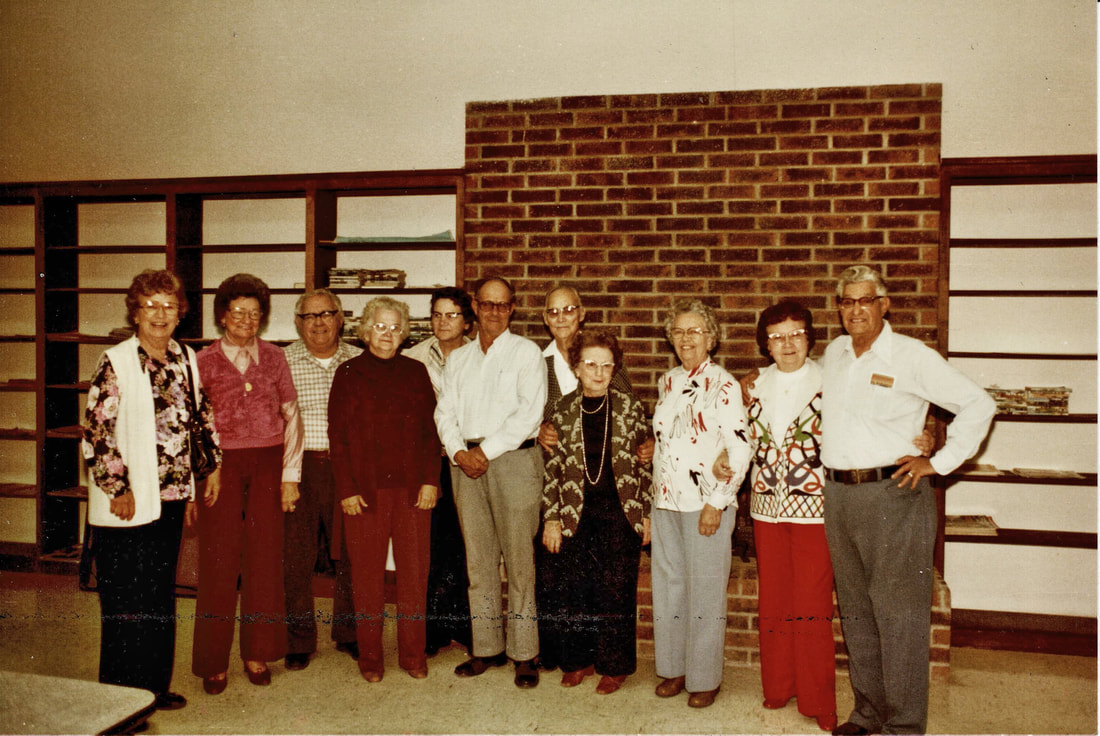
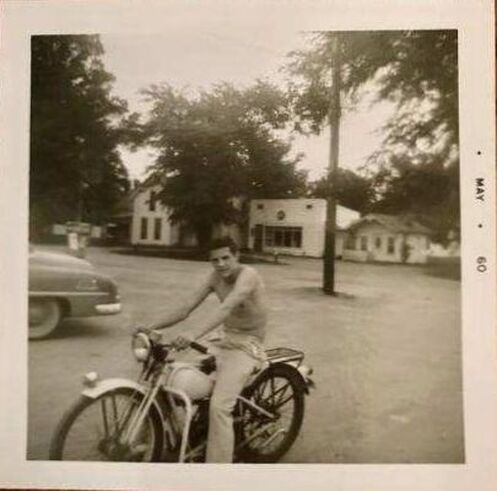
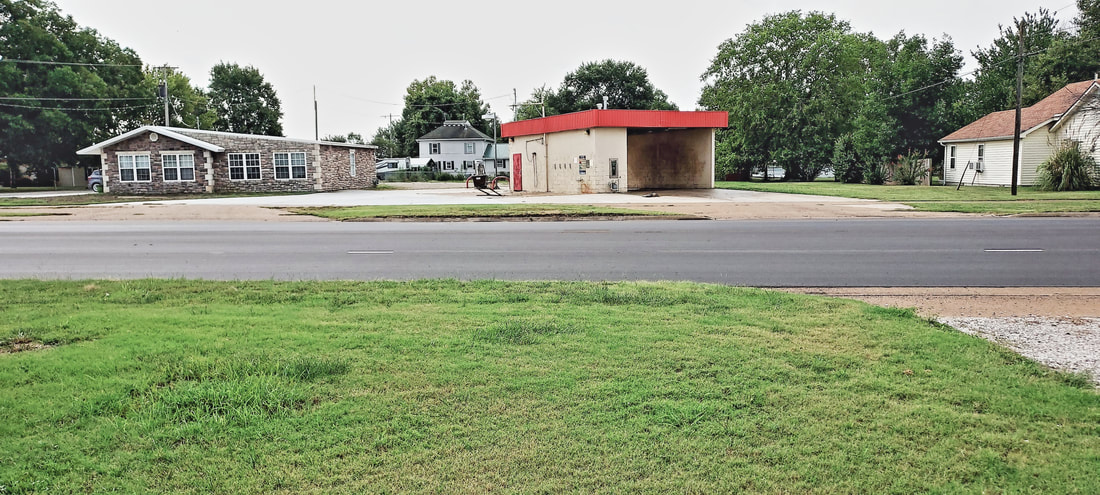


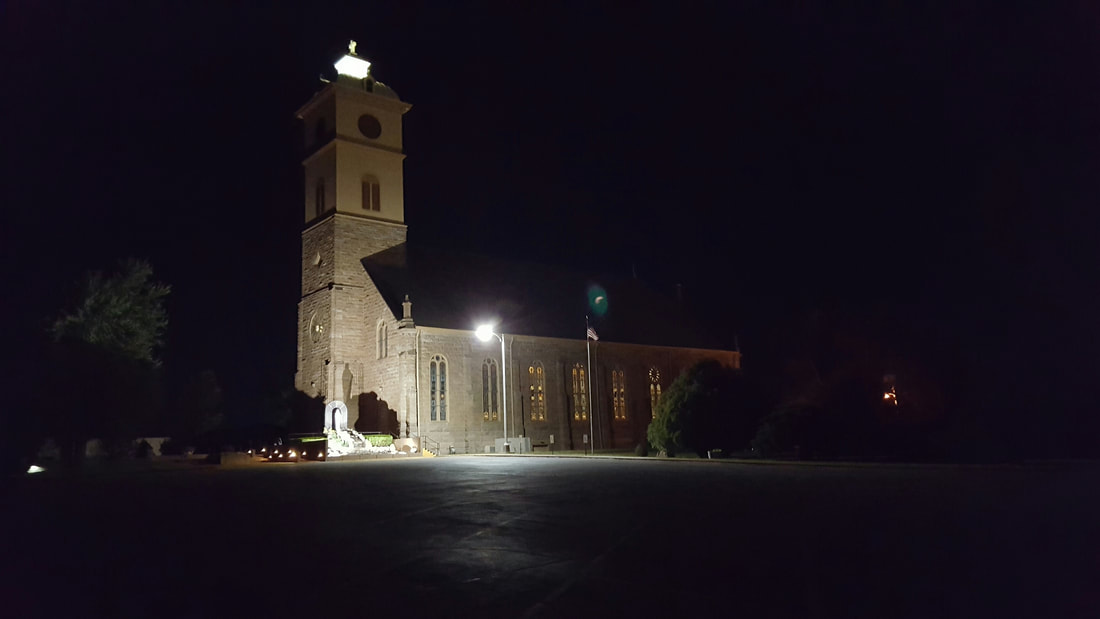
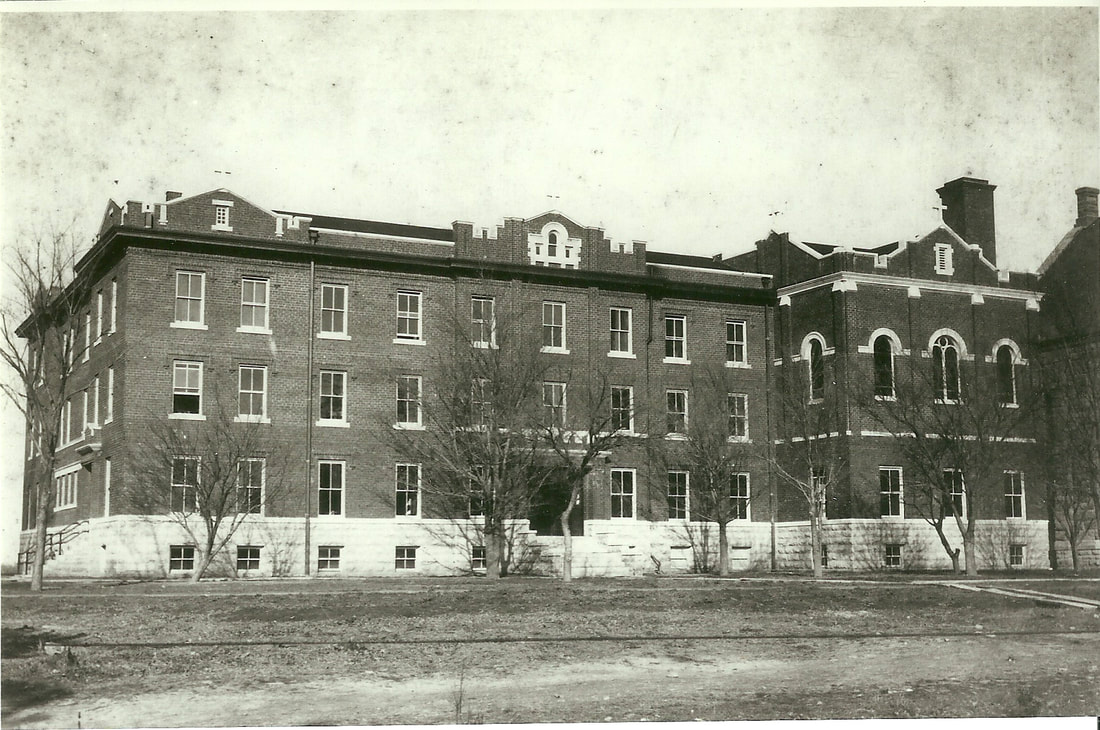
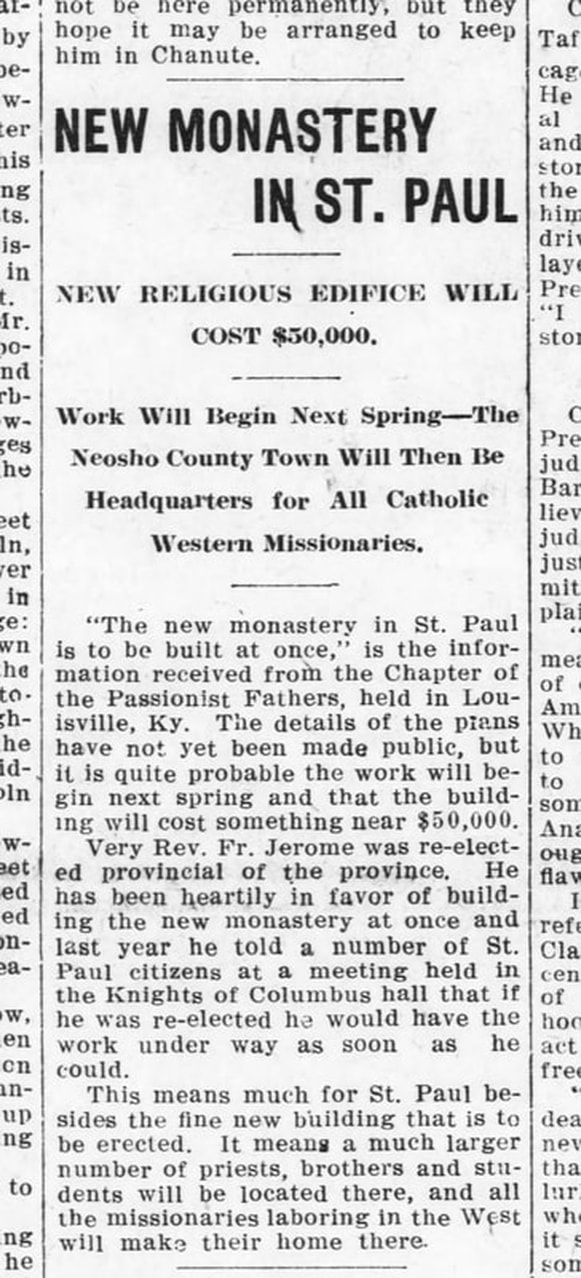
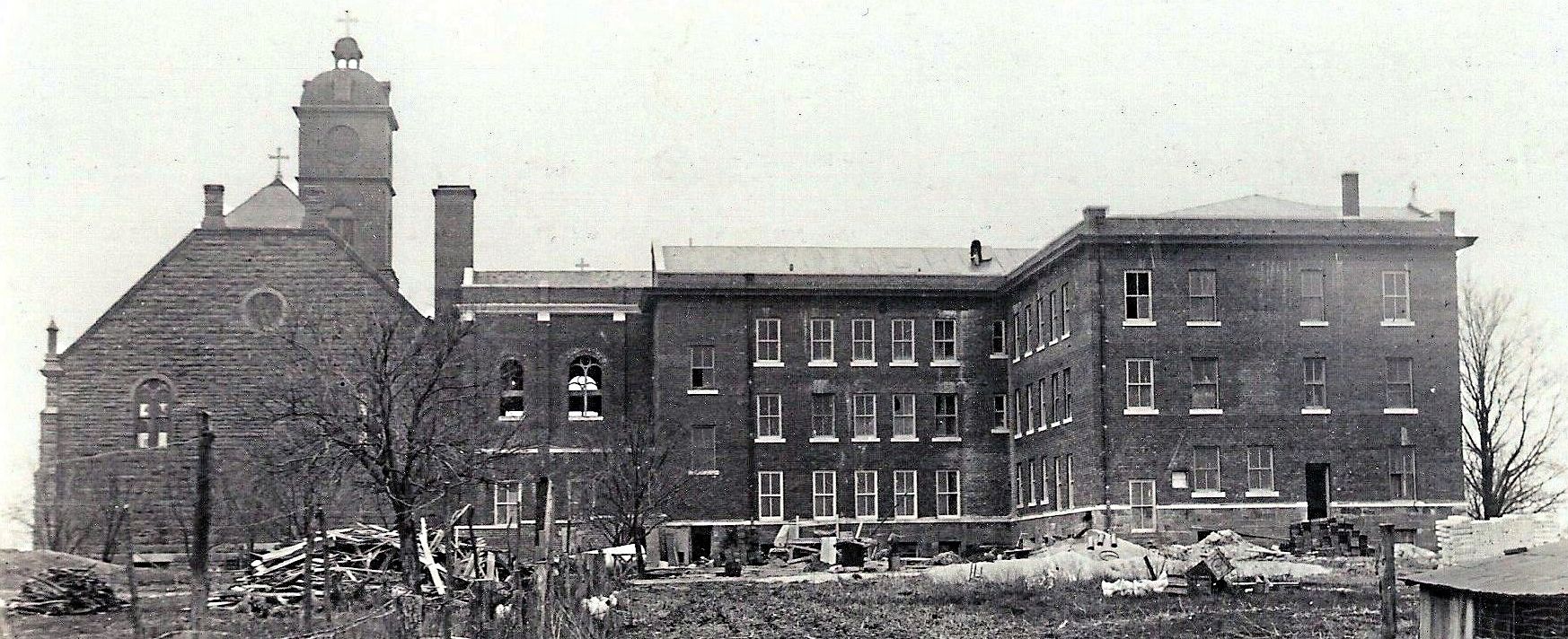

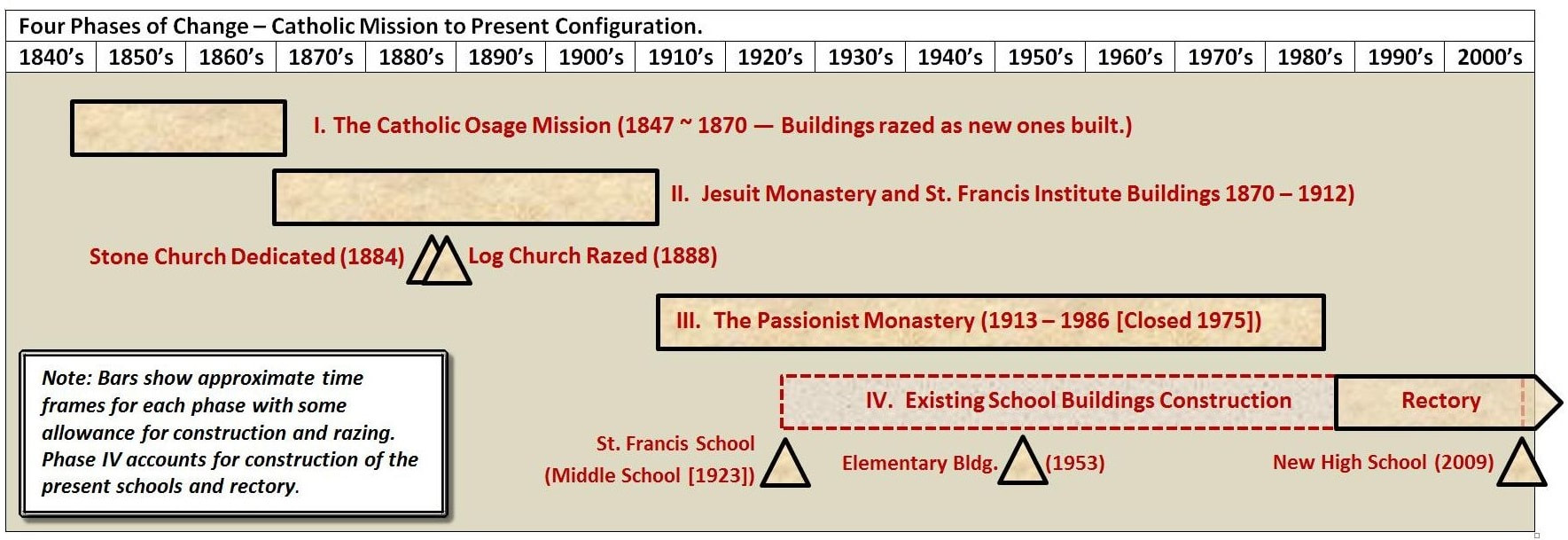
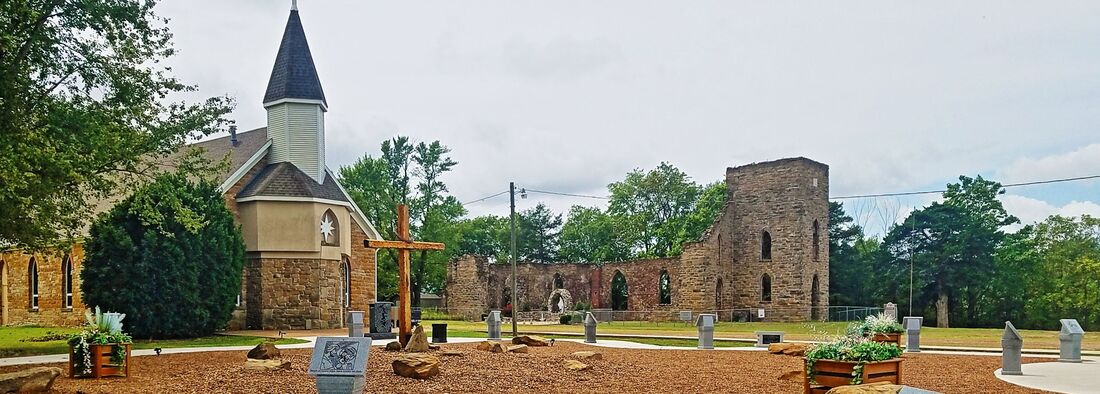
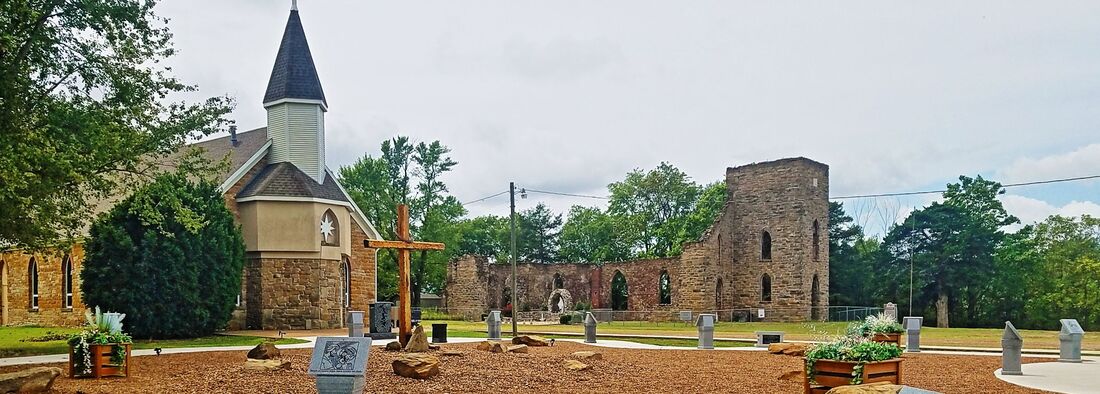
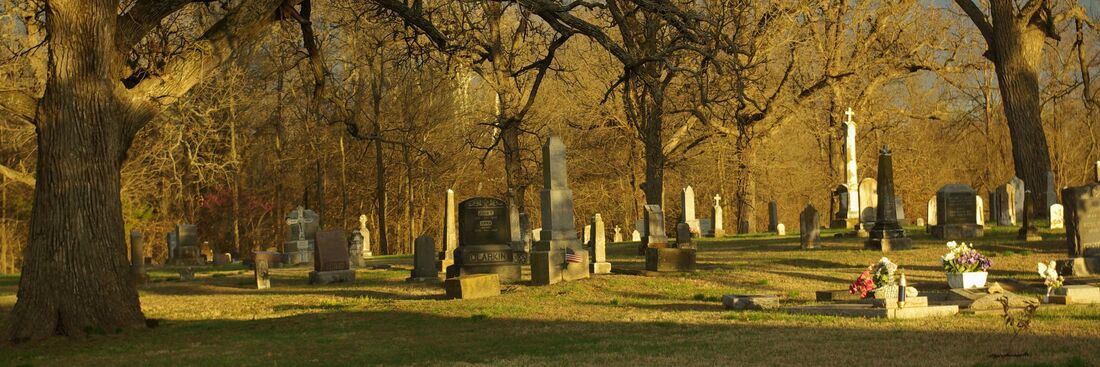
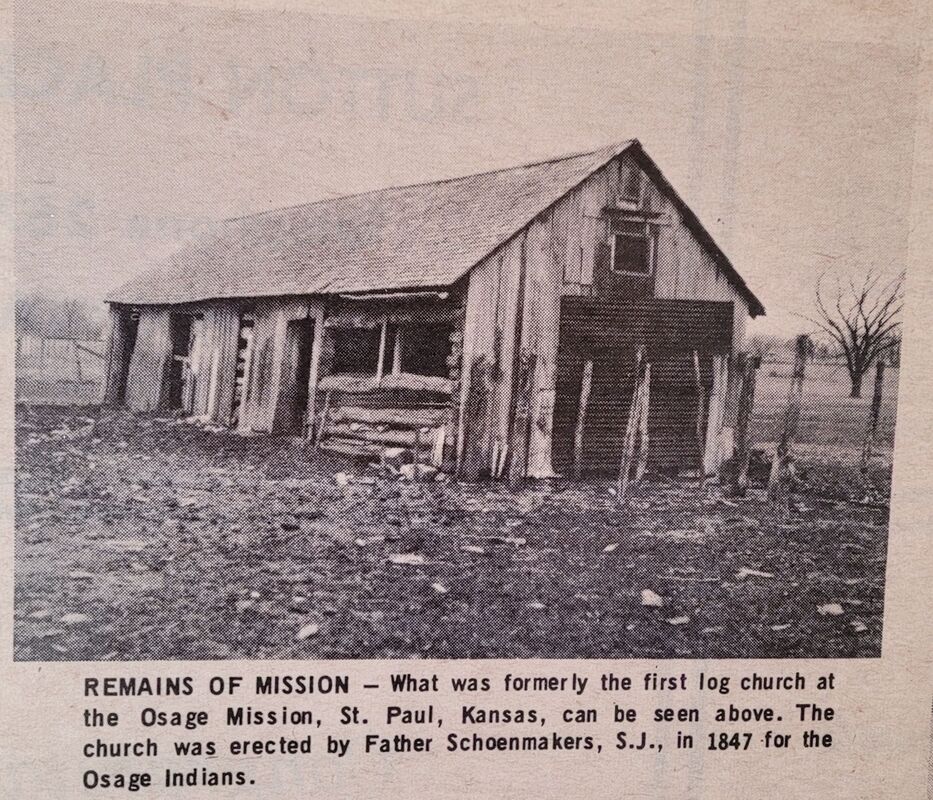
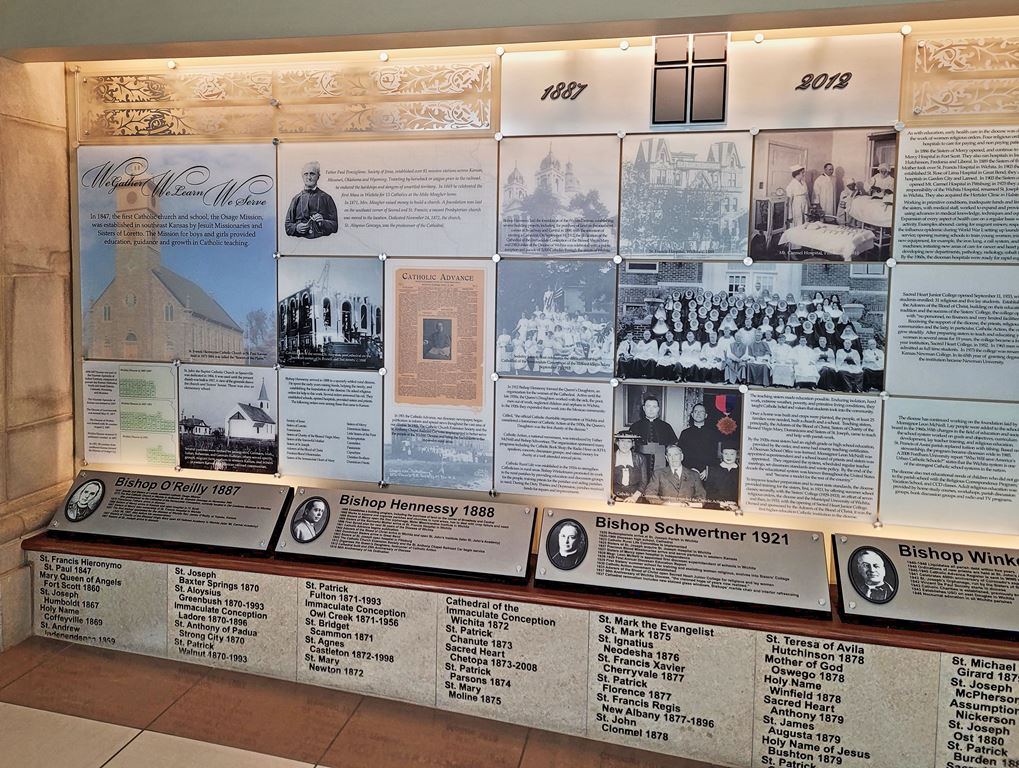

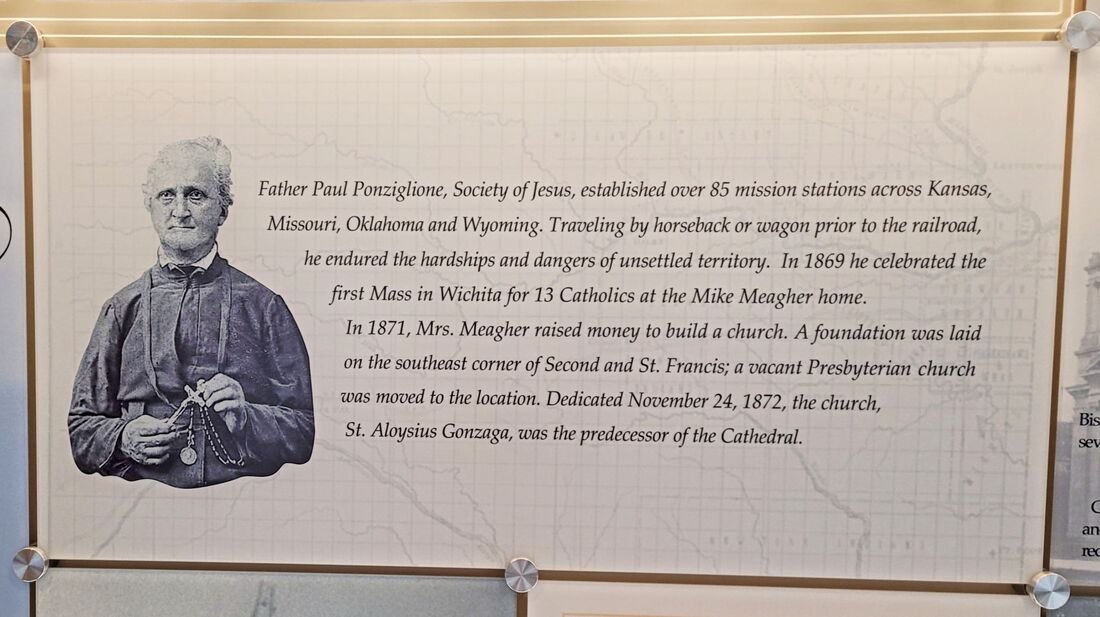
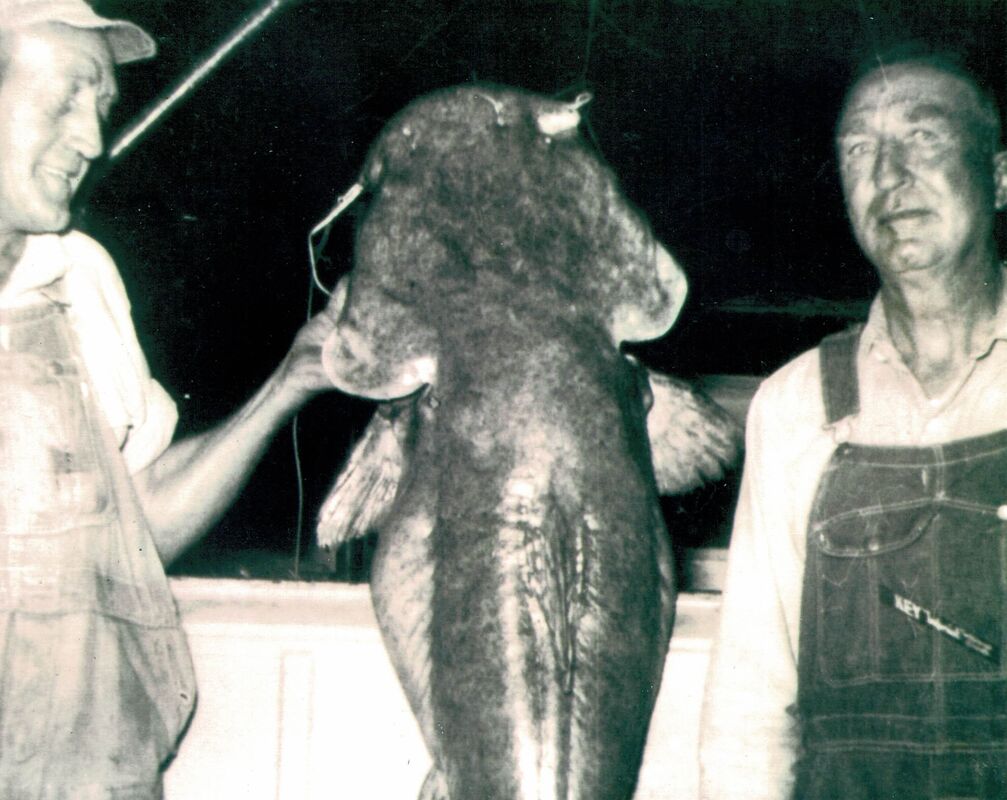
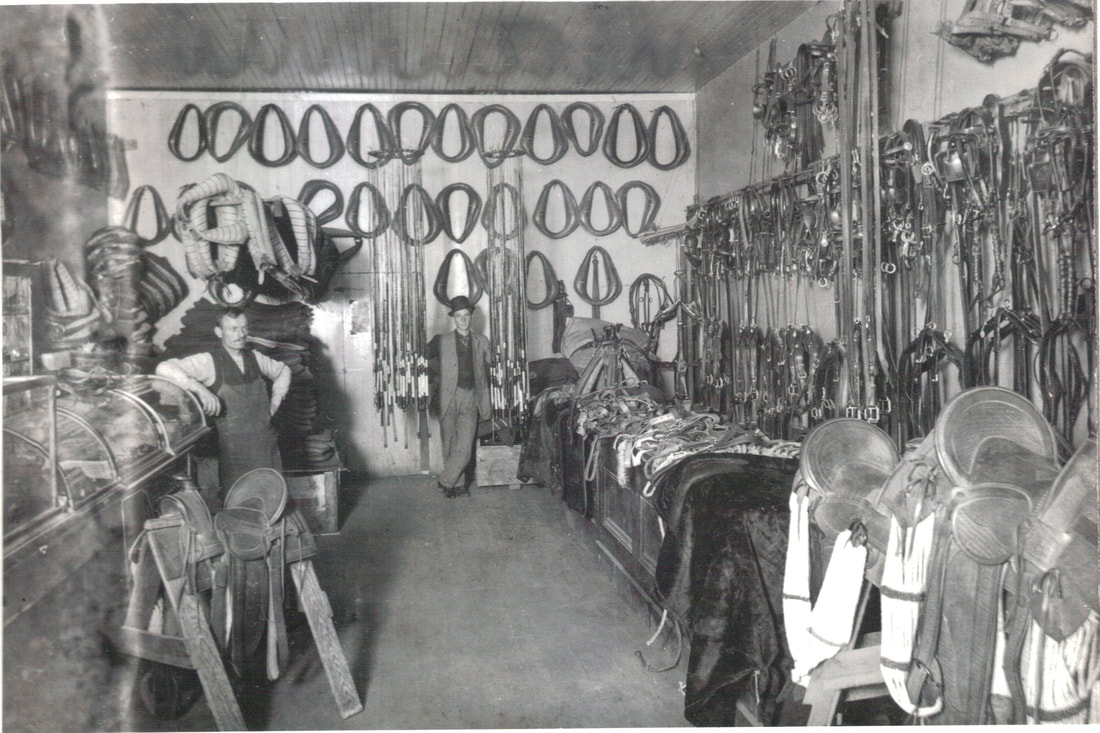
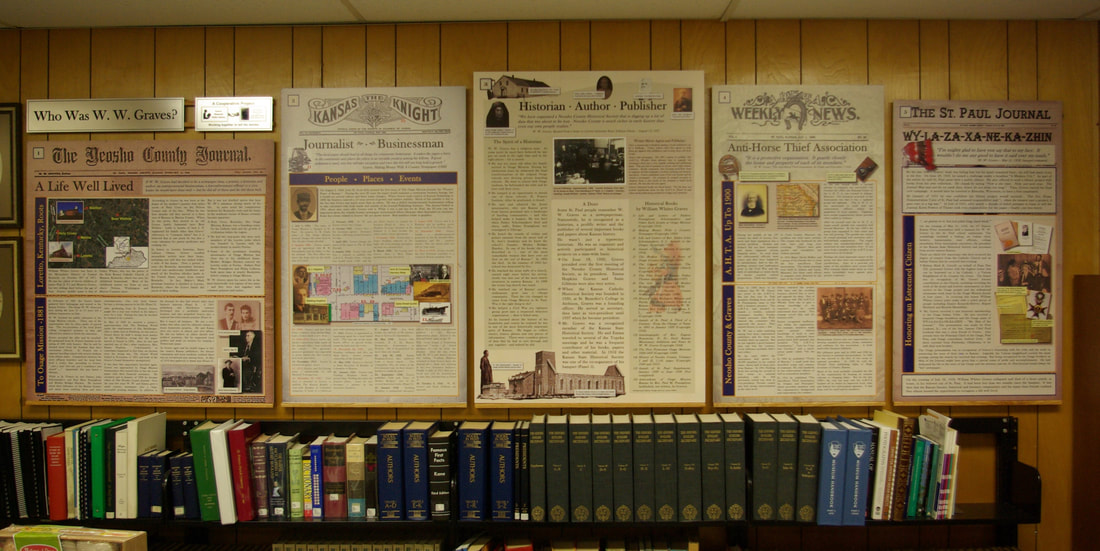
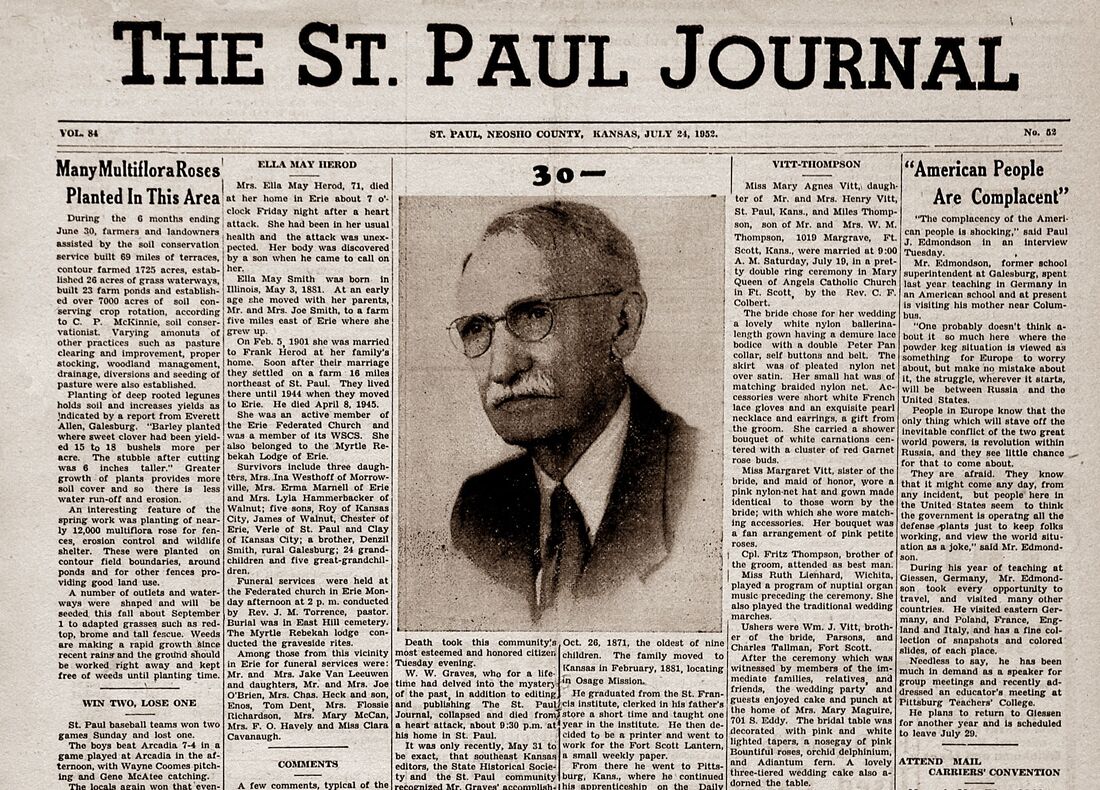
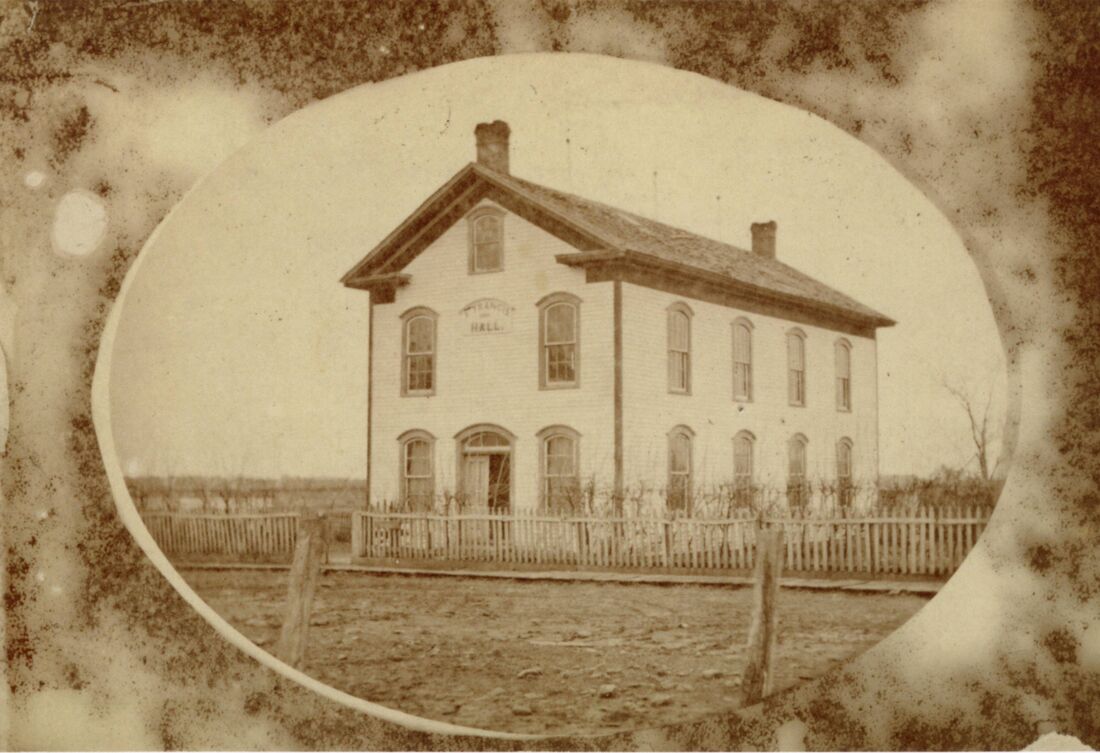
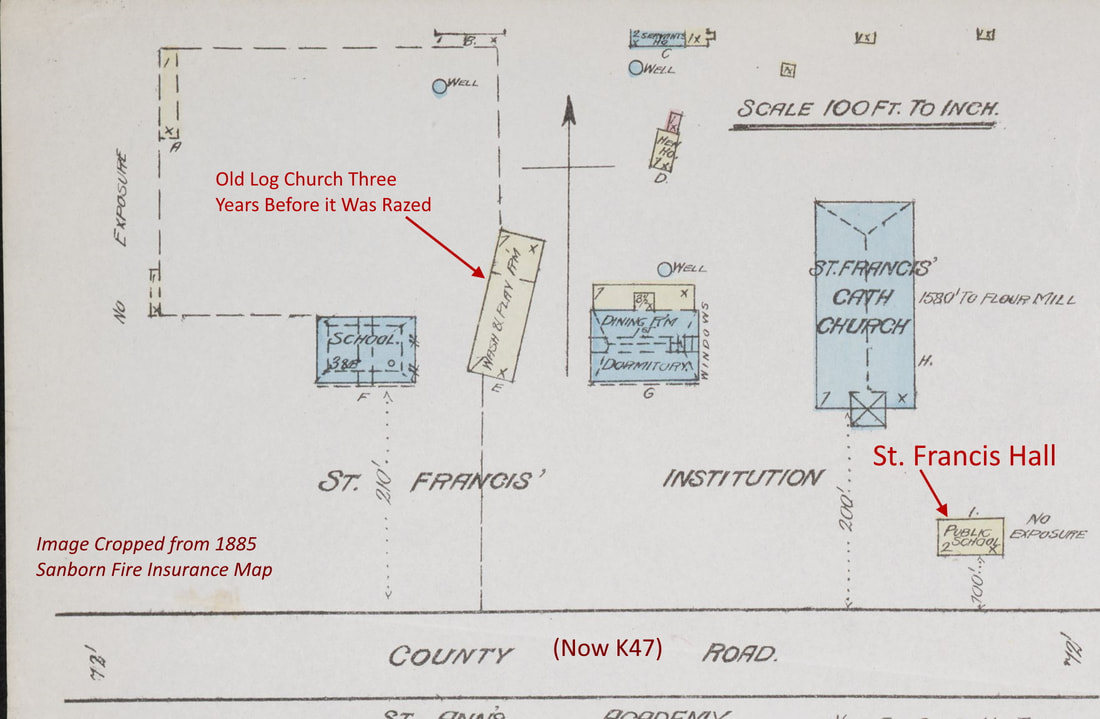
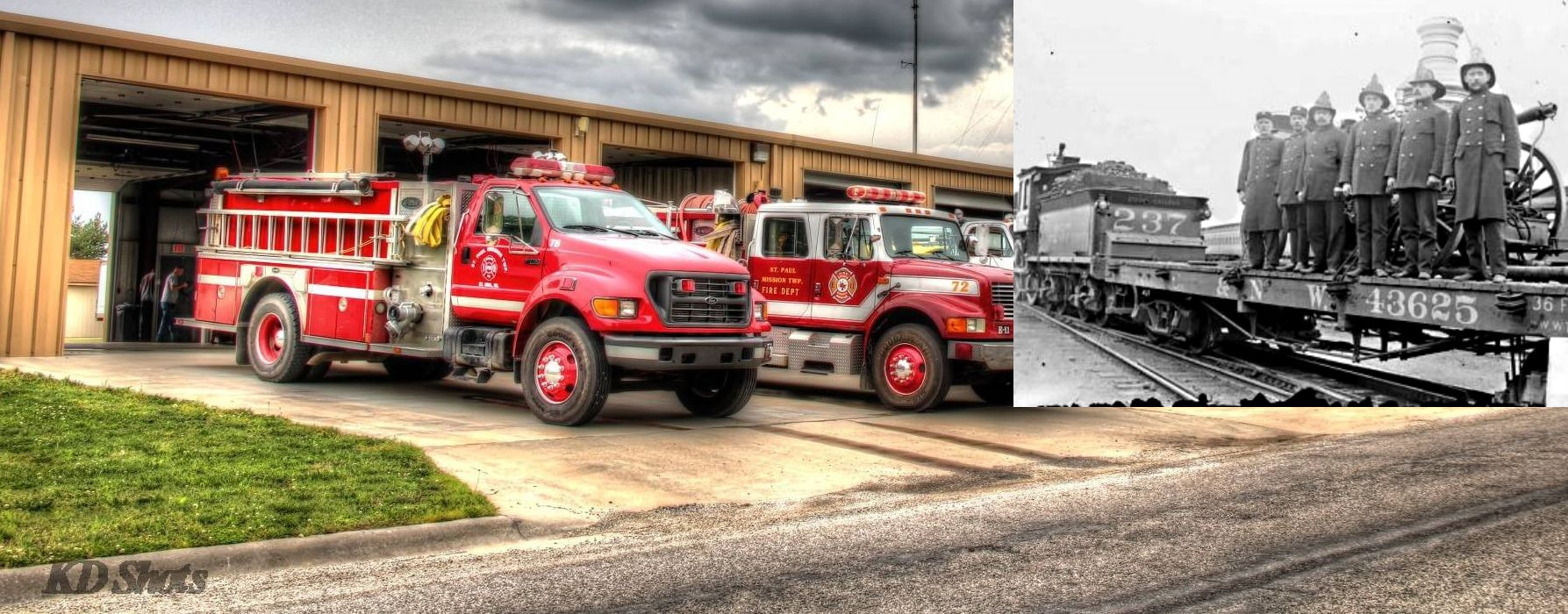


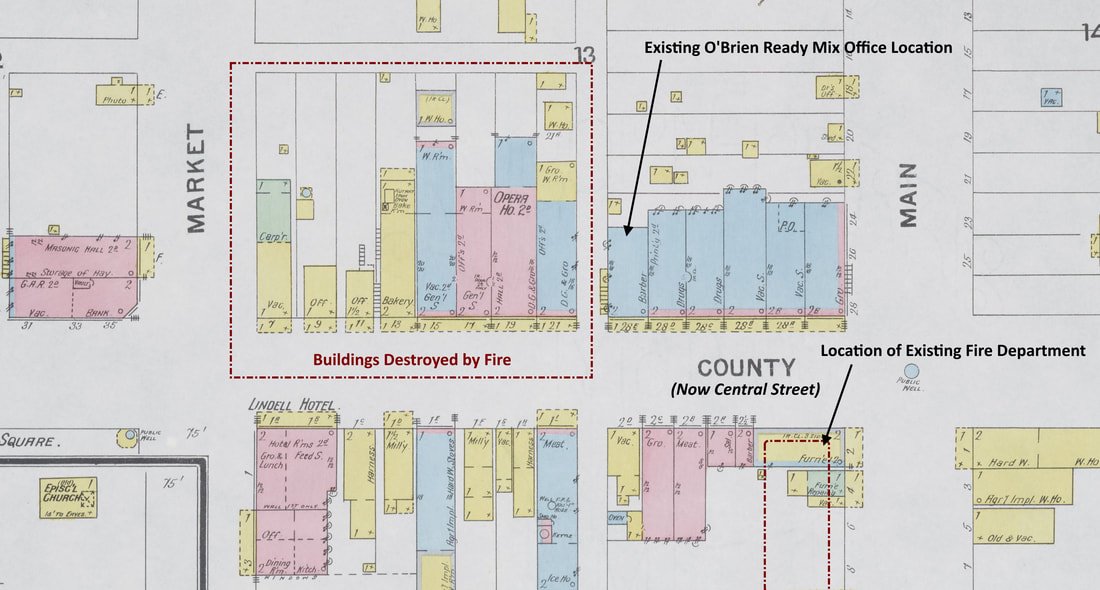
 RSS Feed
RSS Feed